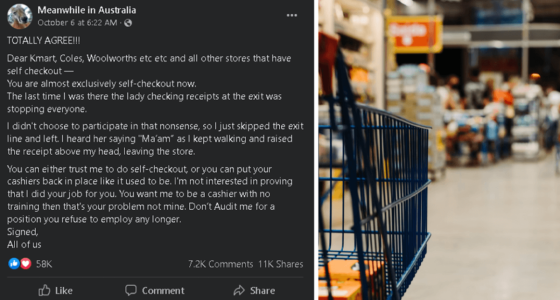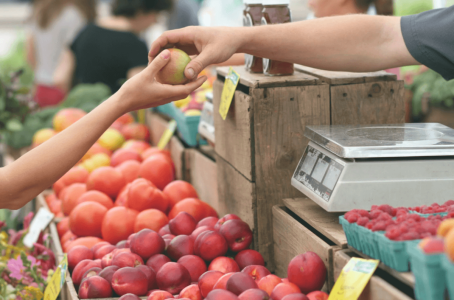In defence of self-service checkouts: Consumer expert responds to shopper's open letter
- Replies 22
It seems that more and more businesses these days are moving to the modern convenience of automated self-checkouts.
We love shopping (more specifically, bargain hunting!) here at the SDC, and retail stores like Kmart, Bunnings, Woolworths, Coles and Target are a few examples of our go-to places.
But for one shopper, recent visits to these big retailers have left a bitter taste in her mouth.
Recently, a scathing open letter criticising self-service checkouts at some of Australia's biggest stores has thrown a spotlight on an issue that many others had been quietly resenting: After relying upon customers to complete the checkout process themselves, why are they then asked to wait and queue up to have their receipts checked at the exit?
The shopper's letter reads: 'You can either trust me to do self-checkout, or you can put your cashiers back in place like it used to be. I'm not interested in proving that I did your job for you.'
The post was quickly shared on social media, and many commenters voiced their agreement with the writer, suggesting this wasn't an isolated incident.

In defence of the increasing number of self-service checkouts in major retailers, consumer advocates have stepped forward to address the issue and defend the stores, with Gary Mortimer from the Queensland University of Technology insisting that the data shows 'more consumers are actually seeking to take control of their own transactions'.
Self-service checkouts are slower than manned checkouts.
According to him, there are definitely long queues at either the staff or self-service registers, but this is mainly due to the holiday season when more and more people are out shopping.
'Progressively, many businesses are implementing different types of smart retail technology that enable them to speed up that final sales process,' he explains.
Why are customers forced to wait in line to have their receipts inspected after self-checkout?
He argues that it's just part of the necessary way to 'combat theft' and something that is done in quite a few stores or businesses regardless of the checkout method.
'If you scan your goods or have someone scan them for you, someone still has to check the receipt when you leave the store,' he says.
This stance has been backed by Director of Store Operations for Kmart and Bunnings in Australia, Ben Camire, who went on to add: 'We treat every customer the same way and with respect'.

Self-service checkouts are taking away jobs from people.
As for the fear that self-checkouts might end up replacing checkout workers completely, Mortimer calms it down by saying that 'it won't mean fewer jobs; it will just mean different jobs'.
He points out that the implementation of such technology has led to an increase in other kinds of roles, such as online grocery pickers, so there's no longer a shortage of retail jobs – even with the big push towards technology.
He adds: 'If we went back five or six years, we wouldn't have those jobs in stores, but now we often see those team members walking along the aisles, picking and packing online orders.'
In short, automated checkout don’t have to mean an end of the checkout role – it may just mean there's a shift in where it is most needed.
Having an employee scan and pack my purchases for me is still the only way to go for me when checking out.
Mortimer promises that major retailers in the country, like Kmart and Bunnings, will never go 100% self-serve, and there will always be a place for traditional checkout people to assist customers in packing their bags and becoming familiar with their purchases.
'I don't think we'll ever get to a stage where there will be no checkout operators and everything will be self-served,' he says.
'I think there will always be a place for team members at the front of the store to assist customers in bringing up their sales and packing up their bags, and there will always be consumers that want that type of service.'

Members, it is definitely an interesting development to consider, and it's probably a good sign that the stores are looking for the best way to speed up your shopping process without compromising your safety and convenience.
It is also nice to take comfort in knowing that we'll still be able to find those old-school cashier services if ever we need them – and that there are job opportunities out there regardless of if we prefer self-serve or a more traditional approach to checkout.
What are your thoughts on this? Let us know in the comments!
We love shopping (more specifically, bargain hunting!) here at the SDC, and retail stores like Kmart, Bunnings, Woolworths, Coles and Target are a few examples of our go-to places.
But for one shopper, recent visits to these big retailers have left a bitter taste in her mouth.
Recently, a scathing open letter criticising self-service checkouts at some of Australia's biggest stores has thrown a spotlight on an issue that many others had been quietly resenting: After relying upon customers to complete the checkout process themselves, why are they then asked to wait and queue up to have their receipts checked at the exit?
The shopper's letter reads: 'You can either trust me to do self-checkout, or you can put your cashiers back in place like it used to be. I'm not interested in proving that I did your job for you.'
The post was quickly shared on social media, and many commenters voiced their agreement with the writer, suggesting this wasn't an isolated incident.

An open letter written by an Australian shopper blasting the self-service checkouts at many major retailers went viral on social media. Credit: Facebook (left), Unsplash/Eduardo Soares (right).
In defence of the increasing number of self-service checkouts in major retailers, consumer advocates have stepped forward to address the issue and defend the stores, with Gary Mortimer from the Queensland University of Technology insisting that the data shows 'more consumers are actually seeking to take control of their own transactions'.
Self-service checkouts are slower than manned checkouts.
According to him, there are definitely long queues at either the staff or self-service registers, but this is mainly due to the holiday season when more and more people are out shopping.
'Progressively, many businesses are implementing different types of smart retail technology that enable them to speed up that final sales process,' he explains.
Why are customers forced to wait in line to have their receipts inspected after self-checkout?
He argues that it's just part of the necessary way to 'combat theft' and something that is done in quite a few stores or businesses regardless of the checkout method.
'If you scan your goods or have someone scan them for you, someone still has to check the receipt when you leave the store,' he says.
This stance has been backed by Director of Store Operations for Kmart and Bunnings in Australia, Ben Camire, who went on to add: 'We treat every customer the same way and with respect'.

Self-service checkouts making their way into more and more stores do not mean fewer jobs for retail workers, says Mortimer. Credit: Pexels/Erik Scheel.
Self-service checkouts are taking away jobs from people.
As for the fear that self-checkouts might end up replacing checkout workers completely, Mortimer calms it down by saying that 'it won't mean fewer jobs; it will just mean different jobs'.
He points out that the implementation of such technology has led to an increase in other kinds of roles, such as online grocery pickers, so there's no longer a shortage of retail jobs – even with the big push towards technology.
He adds: 'If we went back five or six years, we wouldn't have those jobs in stores, but now we often see those team members walking along the aisles, picking and packing online orders.'
In short, automated checkout don’t have to mean an end of the checkout role – it may just mean there's a shift in where it is most needed.
Having an employee scan and pack my purchases for me is still the only way to go for me when checking out.
Mortimer promises that major retailers in the country, like Kmart and Bunnings, will never go 100% self-serve, and there will always be a place for traditional checkout people to assist customers in packing their bags and becoming familiar with their purchases.
'I don't think we'll ever get to a stage where there will be no checkout operators and everything will be self-served,' he says.
'I think there will always be a place for team members at the front of the store to assist customers in bringing up their sales and packing up their bags, and there will always be consumers that want that type of service.'
Key Takeaways
- Shoppers have been vocal online about their frustrations with self-service checkouts in stores such as Kmart, Bunnings, Woolworths and Coles.
- Retail expert Gary Mortimer from the Queensland University of Technology defended the stores and the use of self-service checkouts.
- He highlights the following points: consumers wanting to take control of their own transactions and smart technology making different jobs available.
- He argues stores have always checked receipts at some form of checkout, and there will always be a place for checkout operators.
Members, it is definitely an interesting development to consider, and it's probably a good sign that the stores are looking for the best way to speed up your shopping process without compromising your safety and convenience.
It is also nice to take comfort in knowing that we'll still be able to find those old-school cashier services if ever we need them – and that there are job opportunities out there regardless of if we prefer self-serve or a more traditional approach to checkout.
What are your thoughts on this? Let us know in the comments!







